Malambo kings
by Leila Guerriero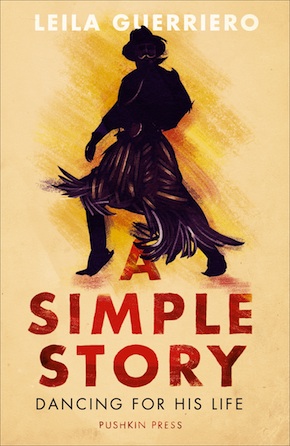
“Guerriero irrefutably proves that journalism can be one of the beaux arts.” Mario Vargas Llosa
Laborde, a town three hundred miles northwest of Buenos Aires in Argentina’s Côrdoba province, was founded in 1903, originally under the name Las Liebres. Populated at the time by Italian immigrants, it now has six thousand inhabitants and is situated in an oasis of wheat and corn dotted with mills. The wheat and corn brought a reasonable level of prosperity to the area, nowadays maintained by soya cultivation, that manifests in towns that seem straight out of the mind of a very orderly, or perhaps psychotic, child: each of the compact town centres features a church, a main square, a town hall, and houses each with their own front garden and the latest gleaming Toyota 4 x 4, sometimes two, parked outside. Route 11 passes through a large number of such towns, places like Monte Maíz, Escalante, Pascanas. Laborde lies between Escalante and Pascanas – church, town square, town hall, houses with front gardens, 4 x 4, et cetera; a town like many others, in an agricultural area like many others; one of thousands of places in the country’s vast interior whose name would ring no bells for most Argentinians. But, for certain people with a very specific interest, Laborde is an important place. In fact, for these people – with this specific interest – there is no place in the world more important than Laborde.
On Monday, 5th January 2009, the Argentinian daily La Nación ran an article in its arts supplement, written by the journalist Gabriel Plaza, with the headline: ‘The folk athletes line up’. Comprising two small columns on the front page and two medium-sized columns a couple of pages in, it included the following lines: “Considered an elite corps within the world of traditional folk dance, past champions, on the streets of Laborde at least, are treated with all the respect of ancient Greek sporting legends.” I hung on to the article – weeks, months, and it was still in my thoughts – and then I found that years had elapsed, and still I was thinking about it. I’d never heard of Laborde before, but once I’d read this piece of red-hot information, the joining together of elite corps and sporting legends with traditional dance and a town in the middle of nowhere… I couldn’t stop thinking. What about? About going and seeing, I suppose.
Photographs from the Laborde Festival © Diego Sampere
Click on any image to enlarge and view in slideshow
…
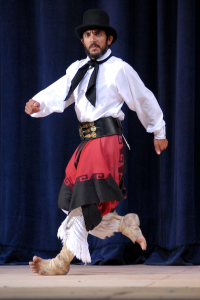 Gaucho, according to the Dictionary of Argentinian Folklore (edited by Félix Coluccio and Susana Coluccio), is “the word used in the Río Plata region – Argentina and Uruguay – to designate the cowboys of these prairie- or pampas-lands… Cowboys and hired hands, by and large, they stood out for their physical prowess, as well as their haughty, reserved and melancholic manner. Almost all their tasks were carried out from the back of a horse, making the animal their best companion, and crucial to the wealth of the gaucho.” The general, perhaps prejudiced view of the gaucho confers very particular characteristics: brave, loyal, strong, indomitable and austere, he is also reserved and arrogant, as well as being prone to the solitary, nomadic life.
Gaucho, according to the Dictionary of Argentinian Folklore (edited by Félix Coluccio and Susana Coluccio), is “the word used in the Río Plata region – Argentina and Uruguay – to designate the cowboys of these prairie- or pampas-lands… Cowboys and hired hands, by and large, they stood out for their physical prowess, as well as their haughty, reserved and melancholic manner. Almost all their tasks were carried out from the back of a horse, making the animal their best companion, and crucial to the wealth of the gaucho.” The general, perhaps prejudiced view of the gaucho confers very particular characteristics: brave, loyal, strong, indomitable and austere, he is also reserved and arrogant, as well as being prone to the solitary, nomadic life.
As for malambo, in the words of the nineteenth-century folklorist Ventura Lynch, it consists of “a joust between men who take turns to dance to music”. A dance the gauchos would challenge one another with, trying to best their opponents in feats of stamina and skill, to the accompaniment of a guitar and a drum. This is the dance Gabriel Plaza’s article was alluding to: malambo, the dance of the gauchos.
Malambo’s origins are unclear, though people agree it probably arrived in Argentina from Peru. Sets of tap dance-like movements, each associated with a certain musical metre, combine to form the ‘figures’. Composed of taps of the toes, soles and heels, pauses on the balls of the feet, and lifts and twists – unimaginable contortions – of the ankles, a malambo performance at the highest level will include more than twenty such figures, divided up by repiqueteos – toe taps at a pace of no fewer than eight per second – requiring enormous responsiveness in the muscles. Each side has to be mirrored, a right-foot figure immediately repeated, identically, with the left foot, so that a dancer of malambo needs equal precision, strength, speed and elegance on both sides. There are two styles: sureño – hailing from Argentina’s southern and central provinces – and norteño – from the north. Sureño is the gentler style, and is accompanied by just the guitar; norteño is more explosive, and calls for both a guitar and a drum. Dancers of each also dress differently: the southern- and central-province dancers wearing a wide-brimmed hat, a white shirt, neckerchief, waistcoat, short jacket, and the cribo – white, flared trousers with tassels and embroidery – over the top of which comes a knee-length section of fabric, somewhat like a skirt, known as the chiripá; a linen cord holds the chiripá up, but a wide, silver-decked belt (known as a rastra) is also worn; on the feet, the so-called ‘foal shoes’, thin leather bindings covering only the heels and middle section of the foot, are tied on with rawhide straps that go over the ankles and around the calves – leaving the front part of the foot and toes bare as they strike the boards. The norteño style includes shirt, a cloth at the neck, jacket, bombachas – flowing, pleated trousers – and knee-high leather boots.
It is in Laborde, this town out in the middle of pampas flatlands, where malambo in its purest form is preserved.”
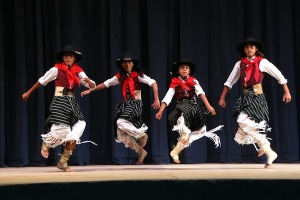 This strictly masculine dance, which began life as a crude kind of gauntlet-throwing, had by the twentieth century been strictly choreographed into performances lasting between two and five minutes. Though best known for the versions seen in ‘for export” spectacles – including hopscotch between candles and the juggling of knives – some traditional festivals in the country do still cleave close to malambo’s essence. But it is in Laborde, this town out in the middle of pampas flatlands, where malambo in its purest form is preserved: since 1966 a prestigious and formidable six-day competition has been held here, one that places fierce physical demands on the participants and concludes with a winner who, not unlike bulls or other thoroughbred animals, is given the title of Champion.
This strictly masculine dance, which began life as a crude kind of gauntlet-throwing, had by the twentieth century been strictly choreographed into performances lasting between two and five minutes. Though best known for the versions seen in ‘for export” spectacles – including hopscotch between candles and the juggling of knives – some traditional festivals in the country do still cleave close to malambo’s essence. But it is in Laborde, this town out in the middle of pampas flatlands, where malambo in its purest form is preserved: since 1966 a prestigious and formidable six-day competition has been held here, one that places fierce physical demands on the participants and concludes with a winner who, not unlike bulls or other thoroughbred animals, is given the title of Champion.
…
As for the prize, the winner can expect neither cash nor a holiday, neither a house nor a car, but simply a rather plain trophy crafted by a local artisan. Laborde’s true prize cannot be seen with the eyes: uppermost in everybody’s thoughts are the prestige and recognition, the endorsement and respect, and the huge honour that come with being one of the best among the select few even able to dance this murderous dance. In the small, courtier-like circle of traditional dance devotees, a Laborde champion becomes a demigod.
And yet… In order to preserve Laborde’s prestige, and affirm its elite nature, a tacit pact has been in place between Laborde champions since the festival’s inception: though they may go and compete elsewhere, they may never enter the Laborde festival again, or dance the solo malambo at other festivals. Should anyone break this pact – there have been two or three exceptions – they’ll suffer the utter contempt and scorn of their peers. So the malambo a man dances to win will also be one of his last: the summit scaled by a Laborde champion is also the end.
In January 2011 I went to Laborde with the simple plan of telling the story of this festival, and of trying to understand why people take part in such a thing: fighting your way to the top, only to come straight back down again.
…
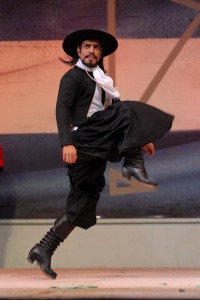 The strumming of Fernando Castro’s guitar resembles a torrent of threats, a foretelling. It contains within it something of avalanches, something of stones, something of thunder: something of the world’s end. Rodolfo comes on from the side, takes a few steps, before pausing to weigh up the magnitude of the task. Then, the remaining steps to centre stage, followed by three furtive, stalking paces towards the audience. He stands, feet apart, arms by his sides, fists clenched. Chords unreel from the guitar, emphatic and resounding, and Rodolfo stamps his feet upon the boards: clack, clack. And, from this moment on, the malambo that ensues takes place on a plane above the surface of the earth. Rodolfo’s legs call to mind a pair of burning eagles and he, gone, no longer of this world, turns imposing, deadly, upright as a tree, clear as a jasmine breeze, rising with a kind of savagery above the delicate movements of the toes, subsiding, kicking out, roaring with all the archness of a feline, gliding along gracefully as a deer, becomes a landslide and at the same time the sea, the churning, crowning foam, before finally stamping his foot down one last time. There he stands: serene, pure, fearsome as a torrent of blood. In a cocky gesture, as if to say, “That was nothing”, he straightens his jacket, before bowing, lightly tipping his hat, and turning and exiting the stage.
The strumming of Fernando Castro’s guitar resembles a torrent of threats, a foretelling. It contains within it something of avalanches, something of stones, something of thunder: something of the world’s end. Rodolfo comes on from the side, takes a few steps, before pausing to weigh up the magnitude of the task. Then, the remaining steps to centre stage, followed by three furtive, stalking paces towards the audience. He stands, feet apart, arms by his sides, fists clenched. Chords unreel from the guitar, emphatic and resounding, and Rodolfo stamps his feet upon the boards: clack, clack. And, from this moment on, the malambo that ensues takes place on a plane above the surface of the earth. Rodolfo’s legs call to mind a pair of burning eagles and he, gone, no longer of this world, turns imposing, deadly, upright as a tree, clear as a jasmine breeze, rising with a kind of savagery above the delicate movements of the toes, subsiding, kicking out, roaring with all the archness of a feline, gliding along gracefully as a deer, becomes a landslide and at the same time the sea, the churning, crowning foam, before finally stamping his foot down one last time. There he stands: serene, pure, fearsome as a torrent of blood. In a cocky gesture, as if to say, “That was nothing”, he straightens his jacket, before bowing, lightly tipping his hat, and turning and exiting the stage.
“Time,” says that voice, deadpan as ever, “four minutes and forty-five seconds.”
When I dash backstage what I find is a scorched-earth scene: Rodolfo and Fernando sharing a wordless embrace, like two men commiserating. Carlos Medina’s eyes are glistening and Miriam Carrizo, with her arms around him, is crying freely. Something must have gone wrong, I think – something my untrained eye didn’t catch. But then Rodolfo takes off his hat, huffs and puffs a bit, and Miriam goes over to hug him, saying: “Brilliant, Rodo. That was a good one.”
Carlos Medina, who seems to be having trouble breathing, looks at me:
“I’ve never seen him dance like that.”
Nearby, in the entrance to a changing room, Sebastián Sayago, who’s on in a couple of minutes, is praying.
…
It’s a little before two in the morning when Sebastián Sayago quits the stage – shouting:
“Shit, fuck, shit!”
His people form a circle around him, saying: “Let it out, that’s it, let it out.” But Sebastián looks furious – he grimaces like he’s in pain. Someone gives him water, Rodolfo and Fernando go over and wish him the best. He vanishes not long after.
Rodolfo enters the changing room, removing jacket, waistcoat, the rastra belt. On his own, wearing just the white, billowing cribo trousers and shirt, he resembles a penitent or an altar boy. The entrants from Buenos Aires, San Luis and La Rioja are out on stage at this particular moment, while outside the changing room a group of girls from another delegation have formed a circle and are reciting, in unison, “Stretch, down, stretch, up” – as they stretch, bend down, stretch, and straighten back up again.
Rodolfo has a sip of water, takes off the shirt and the cribo trousers, and changes into the outfit for the return norteño. Once he’s dressed, he goes out and runs through the entire malambo in the mirror – several people stop and watch in silence. Then he goes back into the changing room, and this time I stay outside taking notes. Next to me a little boy in full gaucho get-up is checking his mobile phone. A few minutes later the red-haired man who announces the dancing order dashes in:
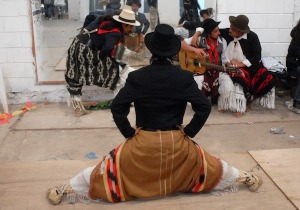 “La Pampa, La Pampa!” he shouts. “ Where’s La Pampa?”
“La Pampa, La Pampa!” he shouts. “ Where’s La Pampa?”
Since nobody says anything, I tell him: “Changing room 4.”
The man darts over and bangs on the door:
“La Pampa is up next in the Senior Soloists!”
This wasn’t the plan: previously the running order had Rodolfo going on in half an hour or so, and I imagine this must be quite a shock. But a provincial delegation is still out on stage and I say to myself, No problem, there’s time… Then I see Miriam come backstage, mobile phone to her ear and a tremendous look of anxiety on her face, and I know something’s really wrong.
“What is it?”
“El Pony, he’s supposed to be drumming for Rodo, but we can’t find him!”
Miriam tries to get hold of El Pony, but he could be in any number of different places – having pizza, giving an interview, signing autographs, anywhere. With these crowds, and with the music playing, there’s no way he’ll hear his phone.
“What’s happening?” Rodolfo asks.
“El Pony,” Miriam says. “He’s vanished.”
How terrible, I think – though I don’t know if I’m thinking this for Rodolfo, for me, or for the both of us.
This is an edited extract from Simple Story: Dancing for His Life, translated by Thomas Bunstead and published by Pushkin Press.
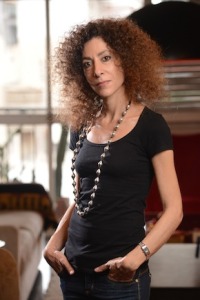 Leila Guerriero was born in Junin, Argentina in 1967 and moved to Buenos Aires in 1984. One of the country’s foremost journalists and writers, she has published articles in numerous newspapers and magazines in South America, Spain and Italy, including El Pais, Vanity Fair and Rolling Stone. In 2010, she won the CEMEX+FNPI Award, the most prestigious journalism prize in Latin America. A Simple Story, her first full-length publication in English, is published by Pushkin Press in hardback at £9.99.
Leila Guerriero was born in Junin, Argentina in 1967 and moved to Buenos Aires in 1984. One of the country’s foremost journalists and writers, she has published articles in numerous newspapers and magazines in South America, Spain and Italy, including El Pais, Vanity Fair and Rolling Stone. In 2010, she won the CEMEX+FNPI Award, the most prestigious journalism prize in Latin America. A Simple Story, her first full-length publication in English, is published by Pushkin Press in hardback at £9.99.
Read more.
Author portrait © Diego Sampere
Thomas Bunstead’s Spanish translations have appeared in Granta, Vice and the Quarterly Conversation, and include work by Eduardo Halfon, Yuri Herrera and Enrique Vila-Matas. He writes for the TLS, the Paris Review blog and 3AM Magazine, and is an editor at the literary translators’ journal In Other Words.
@thom_bunn

